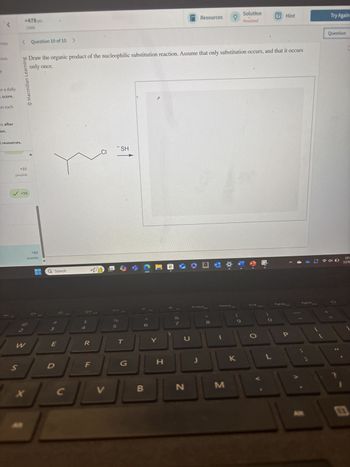
Organic Chemistry: A Guided Inquiry
2nd Edition
ISBN: 9780618974122
Author: Andrei Straumanis
Publisher: Cengage Learning
expand_more
expand_more
format_list_bulleted
Question

Transcribed Image Text:tion.
t
or a daily
I score.
on each
ms after
on.
+478 pts
/1000
< Question 10 of 10 >
Solution
Resources
Hint
Try Again
Penalized
bo Draw the organic product of the nucleophilic substitution reaction. Assume that only substitution occurs, and that it occurs
only once.
© Macmillan Learning
Question
I resources.
+95
possible
✓ +98
2
+90
possible
* F2
SH
CI
Q Search
of
#3
F3
4
»
DII
F4
%
5
F5
a
W
PrtScn
Home
End
PgUp
F9
F10
F6
F7
F8
27
W
E
R
T
Y
U
* 80
S
D
F
G
H
J
K
X
C
V
B
N
M
L
F11
PgDn F12
P
10:1
12/9
E
Expert Solution
This question has been solved!
Explore an expertly crafted, step-by-step solution for a thorough understanding of key concepts.
Step by stepSolved in 2 steps with 5 images

Knowledge Booster
Similar questions
- Hi would you mind finishing question 1? I need to identify which steps show a substitution reaction for the two reactions given. Thank you!arrow_forward-IES.pat Tamaki-Amajiki | De... Popular and Irendi... New lab https://www.gillitv. Sa Re ensation - Drawing i Saved Determine the product formed when butanone (CH CH,COCH2) Is treated with each reagent. If no reaction occurs, label the reaction with "no reaction". PCC H2 Pd-C но он Na,Cr;O7 no reaction [1] LIAIH, [2] H,0 Ag,0 NH,OH NaBH, CH,OH Reset Prev 1 of 11 Next >arrow_forwardOrganic Chem. Lab. Final Examin X aboratory X W JLZFw751UyNbHc3liNfr13gth356g//viewform?edit_requested%3true 54. Bromine test the orange-red.colour of bromine solution disappears when it is added to alor unseturated hydrocarbon saturated hydrocarbon 55. Phenol is prepared in the laboratory bya diazotization of primary aromatic amines secondary aromatic amines tertiary aromatic amines 56. The chemical structural formula beiow is called benzene phenel phenoxidearrow_forward
- Q6arrow_forwardThe reactants, intermediates, final products, and all curved arrows showing bonds forming andbreaking are collectively referred to as the mechanism of a reaction. For the following reactants: a. Explain why the original statement of Markovnikov’s rule does not help in this case, but themodern restatement of Markovnikov’s rule tells you which carbon will get the X (Cl). b. Show the mechanism of the most likely addition reaction between the reactants.arrow_forwardOrg. Chem. 1. EA21arrow_forward
- 3. Draw the reaction mechanism for the following reactions. When possible, label nucleophiles/electrophiles, carbocations, and oxonium ions. H* CI. a) H. + H2O + НОCHЗ H* OH H* H;Carrow_forwardIdentify the major product of the reaction of an alkyne shown below. | ||| OH 1. Hg(OAc)2, H2O 2. NaBH4, NaOH ОН || IV 。 。 Harrow_forwardC OWLV2 | Online teaching and learning resource [Review Topics] [References] Use the References to access important values if needed for this question. Draw the structural formula of the product that would form when 1,3,4-trimethylcyclopentene undergoes catalytic hydrogenation. • You do not have to consider stereochemistry. • You do not have to explicitly draw H atoms. C opy aste ChemDoodle M) Submit Answer Retry Entire Group 4 more group attempts remaining Previous Next Email Instructor Save and Exitarrow_forward
- 4;;arrow_forward1. NaNH2: 2. CH;CH,CHO; 3. H*(quenching): 4. H/Pd/BaSO,/pyridine; 5. OsO,/H,O2 H =H он он он он но HO HO он он но но OH Earrow_forwardWhat is the major organic product of the following reaction? OA OB O C A. Problem viewing the image. Click Preview Here OD B. C. D. 1. KMNO4, "OH, boil 2. H3O+ H OHarrow_forward
arrow_back_ios
SEE MORE QUESTIONS
arrow_forward_ios
Recommended textbooks for you
 Organic Chemistry: A Guided InquiryChemistryISBN:9780618974122Author:Andrei StraumanisPublisher:Cengage Learning
Organic Chemistry: A Guided InquiryChemistryISBN:9780618974122Author:Andrei StraumanisPublisher:Cengage Learning

Organic Chemistry: A Guided Inquiry
Chemistry
ISBN:9780618974122
Author:Andrei Straumanis
Publisher:Cengage Learning